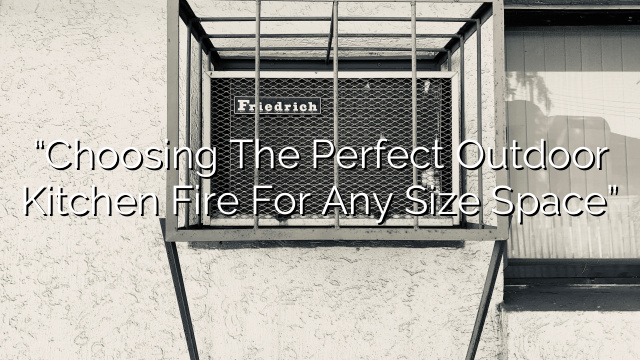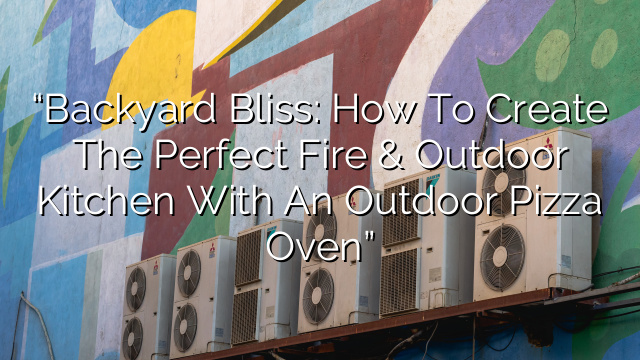Introduction
Outdoor kitchens have become increasingly popular among homeowners who want to make the most of their outdoor living space. Not only do these kitchens provide a convenient way to cook and entertain outside, but they also add value to a home and create a welcoming environment for guests. One of the key decisions homeowners have to make when designing an outdoor kitchen is the choice of materials. In this guide, we’ll explore the different material options available for outdoor kitchens and their benefits.
1. Carbon Steel
Carbon steel is a popular choice for outdoor kitchen countertops and cabinets. It is durable, heat-resistant, and easy to clean. Carbon steel can be finished with various coatings to prevent rust and corrosion, making it ideal for outdoor use. However, it can scratch and dent more easily than other materials, so it’s important to take extra precautions to keep it looking its best.
2. Composite
Composite materials, such as composite decking or countertops, are made from a combination of plastic and wood fibers. They are highly resistant to moisture, stains, and fading, making them a popular choice for outdoor kitchens. Composite materials are also available in a wide range of colors and styles, allowing homeowners to create a custom look for their outdoor space.
3. Concrete
Concrete countertops and cabinets are a durable and versatile option for outdoor kitchens. They can be customized with various finishes and colors, including stamped designs and textured patterns. Concrete is also resistant to heat, making it perfect for grilling and cooking. However, it can be prone to cracking if not properly sealed and maintained.
4. Face Brick
Face brick is a traditional and timeless material for outdoor kitchens. It is made from clay and can be laid in various patterns and colors to create a unique look. Face brick is durable, fire-resistant, and low-maintenance, making it a popular choice for outdoor cooking areas. However, it can be more expensive than other materials and may require professional installation.
5. Marble/Granite Top
Marble and granite are natural stone materials that are commonly used for outdoor kitchen countertops. They are durable, heat-resistant, and come in a wide variety of colors and patterns. Marble and granite countertops can add a touch of elegance and luxury to any outdoor space. However, they can be more expensive than other materials and require regular sealing to prevent staining and damage.
6. Stainless Steel
Stainless steel is a popular choice for outdoor kitchen appliances and cabinets. It is durable, heat-resistant, and easy to clean. Stainless steel gives outdoor kitchens a sleek and modern look and is often used in professional-grade kitchens. However, it can show fingerprints and scratches more easily than other materials.
7. Stone
Natural stone, such as limestone or sandstone, can be used for outdoor kitchen countertops, cabinets, and flooring. Stone is durable, heat-resistant, and adds a natural and rustic look to outdoor spaces. It is also low-maintenance and stays cool in hot weather, making it comfortable to stand on. However, certain types of stone can be prone to staining and may require regular sealing.
8. Stucco
Stucco is a versatile and affordable material for outdoor kitchen cabinets and walls. It can be customized with various colors and textures to match any outdoor design style. Stucco is resistant to heat and moisture, making it suitable for outdoor use. However, it may require occasional repairs and touch-ups to maintain its appearance.
9. Tile Top
Tile is a popular choice for outdoor kitchen countertops and backsplashes. It is available in a wide range of colors, shapes, and patterns, allowing homeowners to create a unique look for their outdoor space. Tile is durable, heat-resistant, and easy to clean. However, the grout lines between the tiles can be prone to staining and require regular maintenance.
Conclusion
Choosing the right material for your outdoor kitchen is an important decision that can greatly impact its durability, appearance, and functionality. From carbon steel to tile top, there are numerous options available to suit every homeowner’s style and budget. Consider the pros and cons of each material, as well as your unique needs and preferences, to make an informed decision for your outdoor living space.
FAQ
- What is the best material for an outdoor kitchen countertop?
- Marble and granite are the best materials for outdoor kitchen countertops due to their durability, heat-resistance, and aesthetic appeal. They are available in various colors and patterns, allowing homeowners to create a custom look for their outdoor space.
- Which material is the most affordable for outdoor kitchen cabinets?
- Stucco is the most affordable material for outdoor kitchen cabinets. It is versatile, can be customized with different colors and textures, and is resistant to heat and moisture. Stucco is a budget-friendly option that can provide a stylish and durable finish for outdoor cabinets.
- How do I clean and maintain stainless steel appliances in an outdoor kitchen?
- To clean stainless steel appliances in an outdoor kitchen, use a mild soap or stainless steel cleaner and a soft cloth. Avoid using abrasive cleaners or scrub brushes that can scratch the surface. Regularly wipe down the appliances to remove any fingerprints or smudges, and dry them thoroughly to prevent water spots.
- Is carbon steel a good choice for outdoor kitchen cabinets?
- Carbon steel can be a good choice for outdoor kitchen cabinets due to its durability and heat-resistance. However, it is important to note that carbon steel can scratch and dent more easily than other materials. To maintain its appearance, it’s recommended to take extra precautions and regularly clean and protect the cabinets.
- Can I use tile for outdoor kitchen flooring?
- While tile can be used for outdoor kitchen flooring, it’s important to choose a tile that is specifically designed for outdoor use. Outdoor tiles are typically made from materials that are resistant to moisture, freezing temperatures, and heavy foot traffic. It’s also important to properly seal the grout lines to prevent staining and damage.














